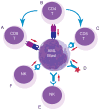New approaches for the immunotherapy of acute myeloid leukemia
- PMID: 25977190
- PMCID: PMC4628787
New approaches for the immunotherapy of acute myeloid leukemia
Abstract
Acute myeloid leukemia (AML) is a set of related diseases characterized by the immortalization and uncontrolled expansion of myeloid precursor cells. Core therapy for AML has remained unchanged for nearly 30 years, and survival rates remain unsatisfactory. However, advances in the immunotherapy of AML have created opportunities for improved outcomes. Enforcing a tumor-specific immune response through the re-direction of the adaptive immune system, which links remarkable specificity with potent cytotoxic effector functions, has proven particularly compelling. This may be coupled with immune checkpoint blockade and conventional therapies for optimal effect. Engineered antibodies are currently in use in AML and the repertoire of available therapeutics will expand. NK cells have shown effectiveness in this disease. New methods to optimize their activation and the targeting of AML show potential. Most significantly, adoptive immunotherapy with tumor-specific T cells, and particularly T cells re-directed using genetically introduced TCR or chimeric antigen receptors, have demonstrated promise. Each of these approaches has unique benefits and challenges that we explore in this review.
Figures

Similar articles
-
Adoptive cell therapy for acute myeloid leukemia.Leuk Lymphoma. 2019 Jun;60(6):1370-1380. doi: 10.1080/10428194.2018.1553300. Epub 2019 Jan 10. Leuk Lymphoma. 2019. PMID: 30628504 Review.
-
Chimeric antigen receptor engineering: a right step in the evolution of adoptive cellular immunotherapy.Int Rev Immunol. 2015 Mar;34(2):154-87. doi: 10.3109/08830185.2015.1018419. Int Rev Immunol. 2015. PMID: 25901860 Review.
-
The progress and current status of immunotherapy in acute myeloid leukemia.Ann Hematol. 2017 Dec;96(12):1965-1982. doi: 10.1007/s00277-017-3148-x. Epub 2017 Oct 28. Ann Hematol. 2017. PMID: 29080982 Review.
-
Immunotherapy for acute myeloid leukemia (AML): a potent alternative therapy.Biomed Pharmacother. 2018 Jan;97:225-232. doi: 10.1016/j.biopha.2017.10.100. Epub 2017 Nov 6. Biomed Pharmacother. 2018. PMID: 29091870 Review.
-
Immunotherapy in acute myeloid leukemia.Immunotherapy. 2014;6(1):95-106. doi: 10.2217/imt.13.152. Immunotherapy. 2014. PMID: 24341888 Review.
Cited by
-
The PI3K-Akt-mTOR Signaling Pathway in Human Acute Myeloid Leukemia (AML) Cells.Int J Mol Sci. 2020 Apr 21;21(8):2907. doi: 10.3390/ijms21082907. Int J Mol Sci. 2020. PMID: 32326335 Free PMC article. Review.
-
A novel allogeneic off-the-shelf dendritic cell vaccine for post-remission treatment of elderly patients with acute myeloid leukemia.Cancer Immunol Immunother. 2018 Oct;67(10):1505-1518. doi: 10.1007/s00262-018-2198-9. Epub 2018 Jul 23. Cancer Immunol Immunother. 2018. PMID: 30039426 Free PMC article. Clinical Trial.
-
Acute myeloid leukemia chimeric antigen receptor T-cell immunotherapy: how far up the road have we traveled?Ther Adv Hematol. 2018 Jun;9(6):135-148. doi: 10.1177/2040620718774268. Epub 2018 May 17. Ther Adv Hematol. 2018. PMID: 29899889 Free PMC article. Review.
-
Concentration-Dependent Decitabine Effects on Primary NK Cells Viability, Phenotype, and Function in the Absence of Obvious NK Cells Proliferation-Original Article.Front Pharmacol. 2021 Oct 25;12:755662. doi: 10.3389/fphar.2021.755662. eCollection 2021. Front Pharmacol. 2021. PMID: 34759824 Free PMC article.
-
Checkpoint inhibition in the bone marrow.Nat Biomed Eng. 2018 Nov;2(11):793-794. doi: 10.1038/s41551-018-0319-6. Nat Biomed Eng. 2018. PMID: 31015619 No abstract available.
References
-
- Bachanova V, Cooley S, DeFor TE, Verneris MR, Zhang B, McKenna DH, Curtsinger J, Panoskaltsis-Mortari A, Lewis D, Hippen K, McGlave P, Weisdorf DJ, Blazar BR, Miller JS. Clearance of acute myeloid leukemia by haploidentical natural killer cells is improved using IL-2 diphtheria toxin fusion protein. Blood. 2014;123(25):3855–3863. - PMC - PubMed
-
- Baker SD, Zimmerman EI, Wang YD, Orwick S, Zatechka DS, Buaboonnam J, Neale GA, Olsen SR, Enemark EJ, Shurtleff S, Rubnitz JE, Mullighan CG, Inaba H. Emergence of polyclonal FLT3 tyrosine kinase domain mutations during sequential therapy with sorafenib and sunitinib in FLT3-ITD-positive acute myeloid leukemia. Clin Cancer Res. 2013;19(20):5758–5768. - PMC - PubMed
-
- Berthon C, Driss V, Liu J, Kuranda K, Leleu X, Jouy N, Hetuin D, Quesnel B. In acute myeloid leukemia, B7-H1 (PD-L1) protection of blasts from cytotoxic T cells is induced by TLR ligands and interferon-gamma and can be reversed using MEK inhibitors. Cancer Immunol Immunother. 2010;59(12):1839–1849. - PMC - PubMed
Publication types
MeSH terms
Substances
Grants and funding
LinkOut - more resources
Full Text Sources
Other Literature Sources
Medical

